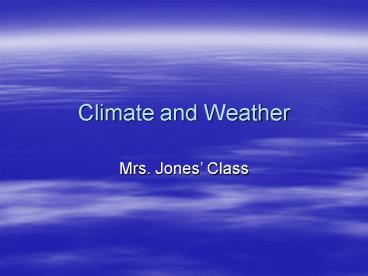Climate and Weather - PowerPoint PPT Presentation
1 / 12
Title:
Climate and Weather
Description:
Valeria, Nancy, Silvia, Abby, Colby, Mckinzie. Climates and How They Change ... Temp zone- cold winters, warm summers, moderate precipitation. ... – PowerPoint PPT presentation
Number of Views:10708
Avg rating:3.0/5.0
Title: Climate and Weather
1
Climate and Weather
- Mrs. Jones Class
2
Weather Systems
- Troposphere is about 15 km thick at the equator.
Stratosphere there is little water in the
stratosphere. - The ozone is important to the Earth by
protecting life on Earth by absorbing some of the
suns harmful rays. - The troposphere layer is where most of the
Earths weather occurs. - Some of the measuring tools are a hygrometer-to
measure humidity, a wind vane to measure wind
direction, and a rain gauge-to measure
precipitation, a barometer- to measure air
pressure, and a thermometer to measure air
temperature.
3
Weather Systems cont
- High air pressure is a cold air mass, low air
pressure is a warm air mass. - Changing air pressure can be used to predict
changing weather with a barometer. - Clouds form by condensation of water in the
troposphere.
4
Weather Systems cont
- Cirrus-thin high clouds made mostly of ice,
cumulus-puffy clouds that usually mean fair
weather, stratus-layered clouds that often
produce rain or snow, and cumulonimbus- high
puffy clouds that are tall and bring
thunderstorms and sometimes hail.
Joey, Danny, London, Adrian A, Adrian S, Rocendo
5
The Causes of Wind
- The atmosphere absorbs some of the suns energy
and reflects some back to space. - These differences causes air to move from the
area to lower pressure. - Earths surface is heated unevenly, the air above
it is in contact motion. - When the warm air gas up it makes a craft.
- Unevenly heating of the Earths surface produces
air masses of different temperature, cold air
sink ,forcing worm air to rise.
6
The Causes of Wind cont
- On a weather map you can find symbols. The red
circles are the warm front, and the blue arrows
are the cold front. - Weather systems are a specific set of weather
conditions. - Prevailing winds that curve to the east, produce
west winds called westerlies. - Westerlies cause weather systems to move from
west to east. - The direction of air flow is changed by the
earths rotation and temperatures and weather
systems move from place to place.
Valeria, Nancy, Silvia, Abby, Colby, Mckinzie
7
Climates and How They Change
- Because the micro climates changes in the area of
the mountains. At the top of a mountain, you will
find a cold and dry climate with few trees and
animals because the clouds with snow in them are
closer to the top which makes it cold and then
the sun heats the top and makes it hot. On the
sides of the mountain, the climate is cool and
moist, and there are tall trees and forest
animals because that s where the trees and
animals can survive. At the base of the mountain,
the climate is warm and dry. Dessert animals and
plants such as sagebrush live there because they
need dry weather. - The temperature differences are determined by, or
the distance a place is from the equator.
8
Climates and How They Change
- Polar zone- cold all year, light precipitation .
Mountain zone- cold winters, cool summers ,
moderate to heavy precipitation . Temp zone- cold
winters, warm summers, moderate precipitation .
Tropical zone- Hot all year , moderate to heavy
precipitation . Desert Zone- Hot summer, cool
winters, light precipitation. - Scientist have evidence that earth is slowly
warming because they study erosion and
deposition.
9
Climates and How They Change
- To determine which areas of North America were
once covered by ice, scientists look for evidence
of glacial erosion and deposition. - Changes in the Earths temperature might be
caused by a change in the size of the Earths
orbit or a change the tilt of Earths axis. - The level of carbon dioxide in the atmosphere has
increased over the past century by the burning of
fossil fuels, it also could because caused by
greenhouse effect. - Warm air is also caused by the burning of fossil
fuels such as gasoline.
Noe, Andrew, Madison, Yesi, Kaitlyn, Lauren
10
Vocabulary
- atmosphere- The layer of air that surrounds
Earth. - precipitation- Any form of water that falls from
clouds, such as rain or snow - evaporation- The process by which a gas changes
back into a liquid. - air pressure- Weight of air.
- condensation- A process by which a gas changes
back into a liquid. - humidity- A measure of the amount of water in the
air.
Joey, Danny, London, Adrian A, Adrian S, Rocendo
11
Vocabulary
- local winds- the winds dependent upon local
changes in temperature. - prevailing winds-winds that blow at the same
direction. - continuous air flow-air that keeps on flowing.
Valeria, Nancy, Silvia, Abby, Colby, Mckinzie
12
Vocabulary
- Climate-The average of all weather conditions
through all seasons over a period of time. - Microclimate-The climate of a very small area.
- El Nino-A short term climate change that occurs
every 2 to 10 years. - greenhouse effect-process by which the earth's
atmosphere absorb heat. - global warming-The hypothesized rise in the earth
average temperatures from excess carbon dioxide - Latitude- an imaginary division of the earth
- heat island- a mass of warm air surrounded by
cooler air
Noe, Andrew, Madison, Yesi, Kaitlyn, Lauren































